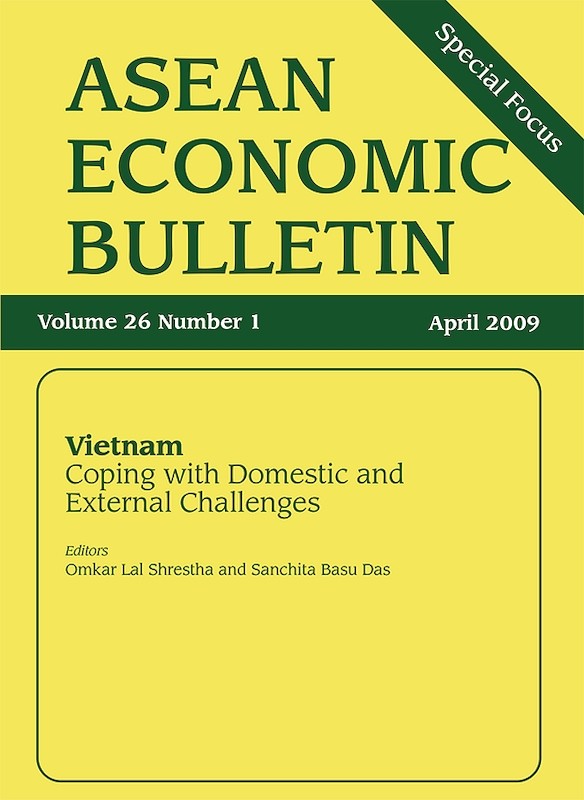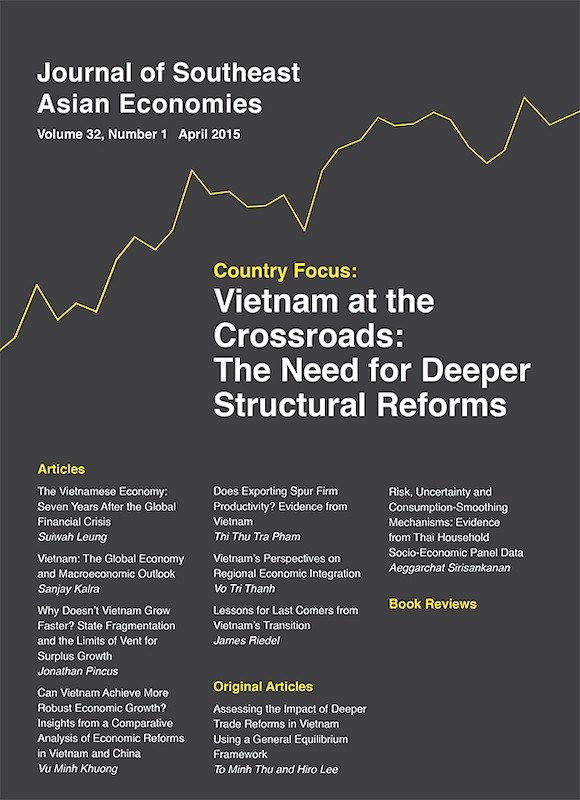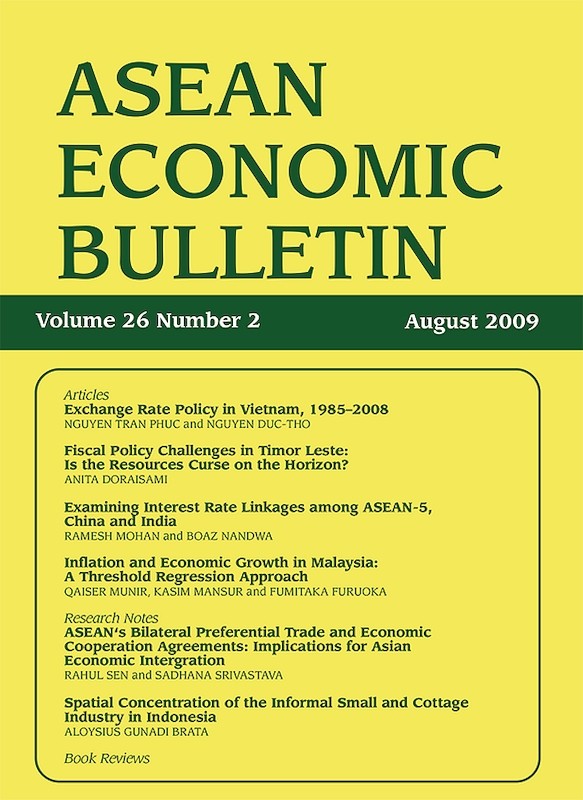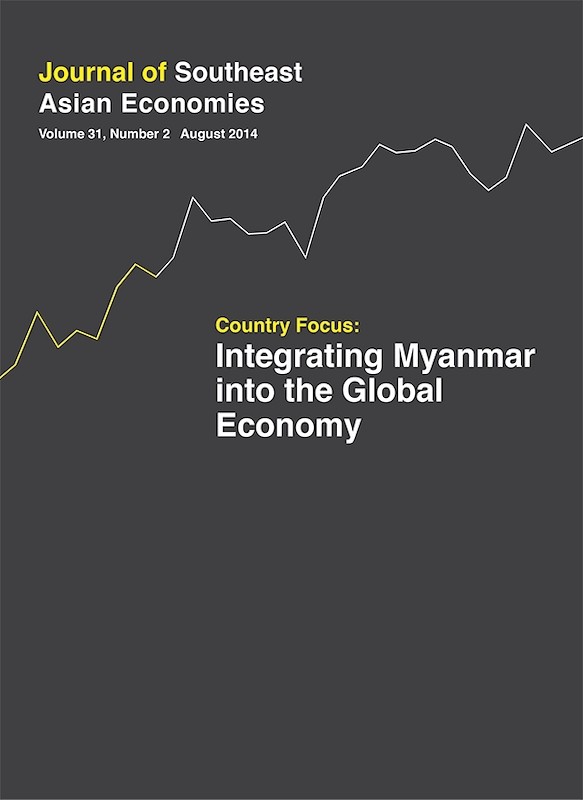ASEAN Economic Bulletin Vol. 26/1 (Apr 2009). Special Focus on "Vietnam: Coping with Domestic and External Challenges"

Date of publication:
April 2009
Number of pages:
138
Code:
AE26/1
Contents
-
ASEAN Economic Bulletin Vol. 26/1 (Apr 2009). Special Focus on "Vietnam: Coping with Domestic and External Challenges"
[Whole Publication] -
Preliminary pages
- ARTICLES
-
Vietnam: Further Challenges in 2009, by Sanchita Basu Das, Omkar Lal Shrestha, authors see abstractThis special issue of ASEAN Economic Bulletin zeroes in on the challenges faced by one of the emerging ASEAN economies, Vietnam. Vietnam, which was hailed as a miracle economy in the recent years, came under severe pressure in 2008. Inflation rose, real estate market crashed, and stock market burst. It was in the second half of 2008, as the central bank's policy measures came into play and global economies slowed, Vietnam could rein in its macroeconomic meltdown. Going into 2009, with external demand still showing no signs of recovery, Vietnam will face a slower growth. The paper further gives some policy options for Vietnam to restructure its economy and deliver good quality growth. Finally, the paper previews the articles contained in this special issue on Vietnam.
-
Vietnam: Sustaining Growth in Difficult Times, by Jonathan Pincus, author see abstractVietnam has achieved high rates of economic growth for a period of two decades. Growth slowed in 2008 as the government was forced to tighten credit in order to slow down price inflation. With the advent of the global recession, the government must now reverse course and find ways to support demand in the face of declining exports and foreign investment. However, as a small, open economy with a fixed exchange rate and large fiscal and trade deficits, Vietnam's options are limited. The most effective response would be to gradually depreciate the Vietnamese dong to slow the flood of imports and boost export prospects, while redirecting the public investment towards labour rather than import-intensive projects. The government must also find ways to impose discipline on the large state-owned enterprises and control their diversification into financial sector activities.
-
Avoiding the Middle-Income Trap: Renovating Industrial Policy Formulation in Vietnam, by Kenichi Ohno, author see abstractVietnam's growth in the last one-and-half decades has been driven by the liberalization effect and large inflows of external purchasing power. Now that the processes of systemic transition and global integration have deepened, Vietnam needs to create internal value to continue to grow and avoid the "middle-income trap". The country has reached the point where growth towards higher income cannot be secured unless policy making is renovated significantly to activate the country's full potential. The vision of Industrialization and Modernization to be achieved by 2020 must be backed by realistic industrial strategies and concrete action plans, which are currently lacking. Stakeholder involvement in policy design, inter- ministerial coordination, clear directives from the top, and incentive structure for government officials must be improved. This in turn calls for radical changes in policy administration. A new style of leadership, a technocrat team directly serving the top leader, and strategic alliance with international partners are proposed as key entry points for the renovation of Vietnam's industrial policy formulation.
-
Banking and Financial Sector Reforms in Vietnam, by Suiwah Leung, author see abstractThis paper summarizes Vietnam's developments in the banking and financial sector to date. It assesses the system's weaknesses that played an important role during the macroeconomic turbulence of 2008. It then discusses the need for deeper reforms of the country's key macroeconomic institutions. In general, for Vietnam to achieve its goal of becoming a modern industrialized economy by 2020, it needs to have world-class public institutions to complement a flexible and entrepreneurial private sector. Nowhere is this more true than in the banking and financial markets where effective policy-making and skilful regulation have to be balanced against profitable risk-taking - all set against a background of commitment to a one-party state where social and political stability still reigns supreme.
-
Sudden Surge in FDI and Infrastructure Bottlenecks: The Case in Vietnam, by Tien Quang Tran, author see abstractThrough examining trends and patterns of foreign direct investment (FDI) in Vietnam over the twenty years of reform (1986-2008), this paper found a big increase in registered FDI recently. This is not in accordance with the increase in actual capital disbursement because of low absorptive capacity of the economy in terms of poor infrastructure, restricted and unstable policy, and weak competitive capacity of domestic firms. Moreover, newly massive flows of FDI brought an explosion to infrastructure development in the form of office buildings, hotels, industrial zones, resident parks and ports. This could help to improve the situation of infrastructure because it has not kept pace with the rapid economic growth over the past decade and are considered as major constraints in attracting more FDI.
-
Managing Success in Vietnam: Macroeconomic Consequences of Large Capital Inflows with Limited Instruments, by Jayant Menon, author see abstractVietnam has experienced spectacular economic growth over the past decade, and a lot of this has been a result of massive inflows of FDI. Although much has been written on the impact of FDI in developing countries, previous studies have generally ignored macroeconomic consequences in cost-benefit assessments. These macroeconomic aspects can be particularly important in transitional economies like Vietnam, where some of the instruments of macroeconomic stabilization may be blunt or unavailable. First, growth in capital inflow needs to be accommodated by real exchange rate appreciations. In dollarized economies like Vietnam, the nominal exchange rate cannot be relied upon to deliver it, so inflation is usually the result. In dollarized economies, it is also difficult for the central bank to conduct open market operations, in order to sterilize large capital inflows, or mop up excess liquidity. Again, this could add to inflation. The combination of a young and inexperienced banking system and a investment-hungry SOE sector only exacerbates the situation, and increases the risk of imbalances that can result in a crisis.
-
Economic Transition and Export Performance in Vietnam, by Prema-Chandra Athukorala, author see abstractThis paper examines Vietnam's export performance in the process of economic transition. The key theme of analysis is the complementary role of domestic policy shifts and the ongoing changes in world trade patterns in determining trends and patterns of exports. The analysis yields clear evidence that when market forces are unleashed, albeit in a constrained fashion, specialization patterns assert themselves as predicted by the received trade theory. On the contrary, there is no evidence to suggest that the state-mediated attempts in the early stage of reforms to mould the emerging patterns of manufacturing exports had any tangible effect. Vietnam's export performance looks impressive, particularly when we take into account the nature of the reform process, and the constraining effects of the U.S. trade embargo during the first decade of reforms and the historic overwhelming reliance on the Soviet bloc markets.
-
Vietnam after Two Years of WTO Accession: What Lessons Can Be Learnt?, by Vo Tri Thanh, Nguyen Anh Duong, authors see abstractThis paper provides an overview of the socioeconomic changes in Vietnam since its WTO accession in early 2007. This is critical since ex ante studies have all seemed to significantly underestimate the impacts of WTO accession and integration on Vietnam's economy, whilst failing to rigorously analyze foreign capital inflows and related macroeconomic issues. The years 2007-2008 witnessed remarkable improvements in Vietnam's economic performance, from real aspects to social issues and economic institutions. However, quality of growth remained modest, trade deficit widened, inflation surged, while Vietnam's vulnerability to negative external shocks gets increasingly apparent. The paper then draws out several major lessons for Vietnam from its first two years of WTO membership. Areas for further improvements, such as resolutions of bottlenecks to strengthening competitiveness, sustaining development, and building managerial capacity to mitigate macroeconomic and social risks, are also identified.






